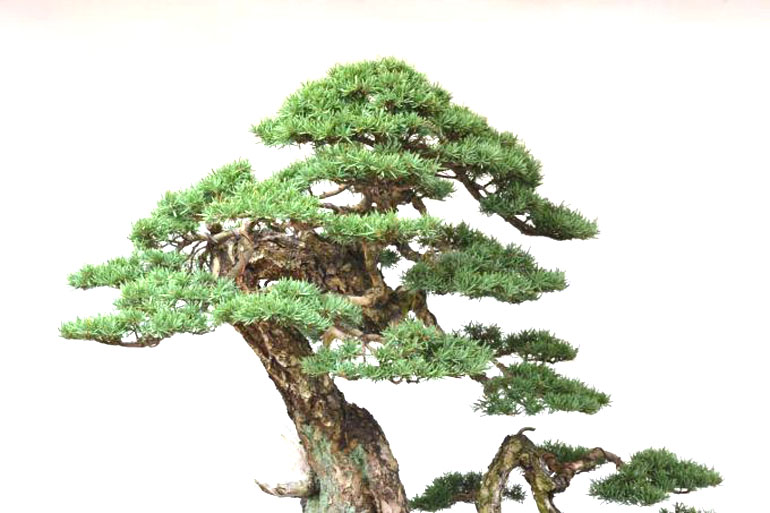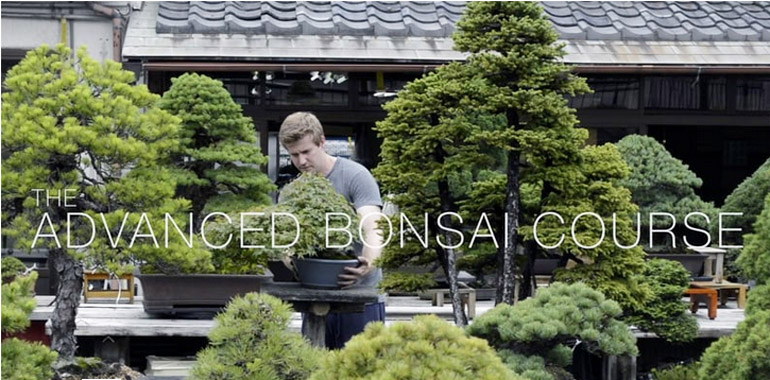A Little Imagination and a Whole Lot of Experience and Skill
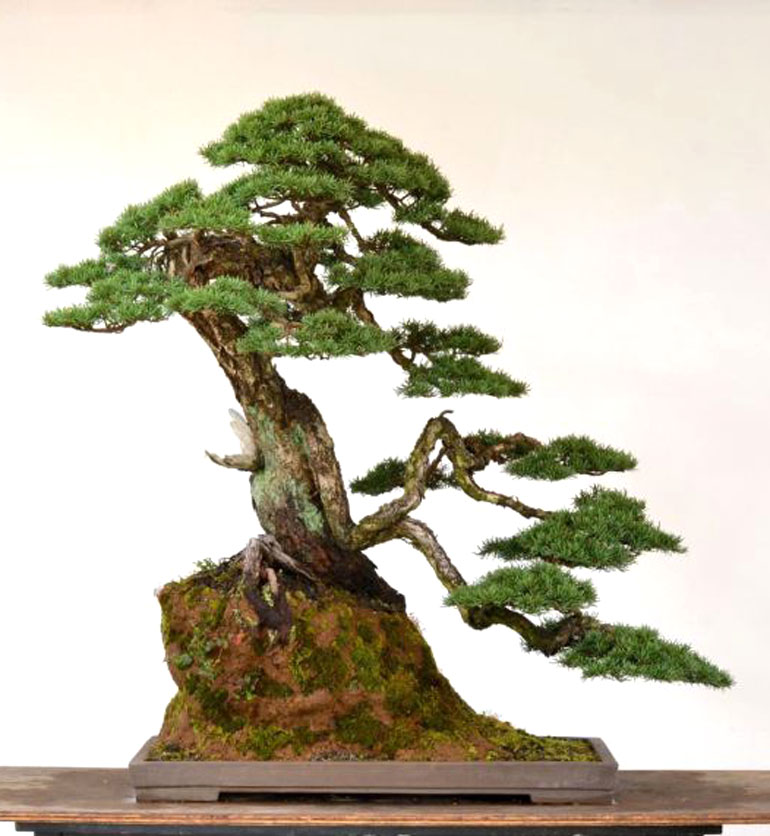
This dramatic Mountain Hemlock was recently restyled (reimagined) by Michael Hagedorn and friends. Here's part of a quote by Michael... "Very old Hemlock .... often have idiosyncratic branching, and in the restyling ... we tried to feature the lines of these unusual branches that were created in the wild, without influence or manipulation in the studio..." The whole quote is below
Michael Hagedorn (Crataegus Bonsai) continues to amaze. With an abiding respect for the tree and an approach that is so uniquely his that you might recognize his trees in an instant. Which in this case is a remarkable old Mountain Hemlock (Tsuga mertensiana). Rather than say more, we’ll let Michael do the talking…
Continued below…

Before. The only things missing are a little imagination and and a whole lot of experience and skill
In Michael’s own words, from his Crataegus blog…
“The completed composition, 36″/ 91 cm. We patched in some moss to jumpstart the desired result of full eventual coverage. The environs of Mountain Hemlock often have great views, high up on rounded terrain with vistas. The cascading drop branch does remind me of being in high country, brushing the clouds, where I’ve often see them. Very old Hemlock in this zone often have idiosyncratic branching, and in the restyling a few years back we tried to feature the lines of these unusual branches that were created in the wild, without influence or manipulation in the studio, simply by choosing an inclination and front that showed off the branches to the best advantage — the decision being that the branches were more interesting than the trunk. In the potting this spring it seemed advantageous to make a high mound to show off the lowest branch, leaving the container with a very minor supporting role.”

A little perspective... assuming these are more or less average size humans
The base of the trunk. It's a little unusual to see major branching so low on a trunk.
The top half of the tree
You Don’t Have to Go to Japan to Study Bonsai with Bjorn
This powerful little White pine-over-rock is from the Fujikawa International School of Bonsai website.
Yesterday we mentioned Bjorn Bjorholm’s upcoming Advanced Bonsai Coourse with Bonsai Empire (see below). This got me thinking about Bjorn’s history here on Bark, so I took a little journey through our archives and came up with this from June, 2013, one of our earliest Bjorn posts
The post was titled Study Bonsai in the Old Country. It featured the Fujikawa International School of Bonsai and Bjorn’s role their at the time. Here’s your link if you’d like a little bonsai history.
NEW SPECIAL
HIGH IMPACT PLASTIC BONSAI POTS
25% OFF LIST PRICES
–
We showed this lovely little pine a few months ago (remember it was 2013) in a post about Bjorn Bjorholm and his Bjorvala Bonsai Studio. I wonder if we would be surprised by the actual size of this tree and the one above, both of which we've referred to as little.
Continued below…
Here’s the course mentioned above…
Bjorn Bjorholm renowned American bonsai artist and teacher doing what he loves
Advanced Bonsai Course
Discounted pre-enrollment for the Advanced Bonsai Course has started! The online course offers unique access to the latest and most advanced Bonsai techniques. Instructor Bjorn Bjorholm guides you through the long-term impact of techniques on a wide variety of tree species.
Disclaimer: No kickbacks, just good karma
This very unusual Shimpaku got sliced a bit (mea culpa, but if you look at the original photo below, you'll understand). Aside from the very radical twist in the trunk, how often do you see a tree where the all the branching and the entire crown are off to the side hanging out in space like this?
There must be another solution to this problem. Still, great tree.
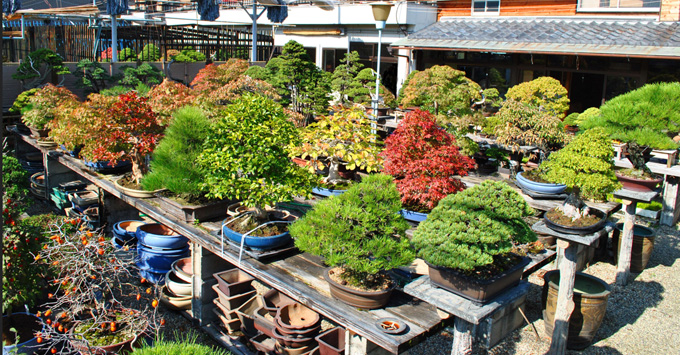 A bright slice of the Kouka-en nursery.
A bright slice of the Kouka-en nursery.
Magnificent Cliff Bonsai & Bjorn’s Advanced Bonsai Course
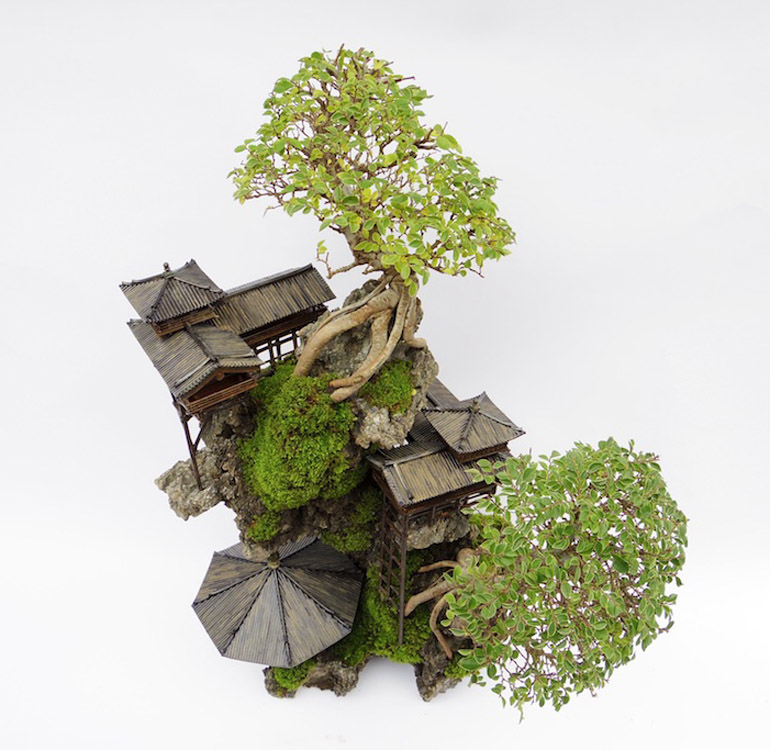
Here's a challenge for you. Take a look at this Cliff Bonsai photo and the next couple (but don't scroll all the way down) and see if you can figure out just how big they are. I borrowed this and the other photos in this post from Bonsai Empire. The artist/mastercraftsman is Daisuke Nakajima.
Here’s what Oscar (Bonsai Empire) wrote about these Cliff Bonsai… “Trees clinging to a steep cliff, roots entangled in solid rock and beautifully detailed miniature buildings – welcome to the mysterious world of “Cliff Bonsai”. Japanese artist Daisuke Nakajima created these four stunning miniature landscapes, and agreed to share his creations with us. Enjoy!”
While we’re on Bonsai Empire… Bjorn Bjorholm together with Bonsai Empire is offering a new Advanced Bonsai Course (see below).
–
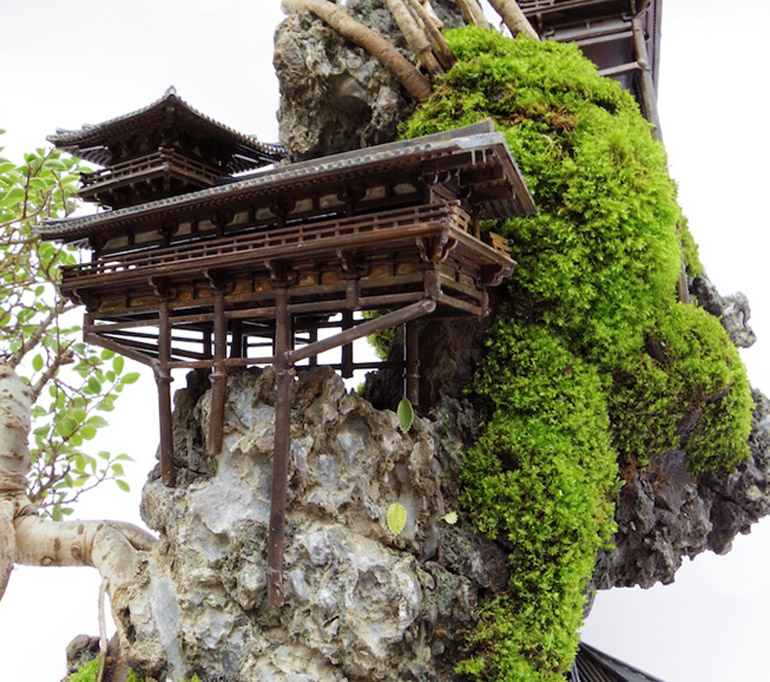
Close up
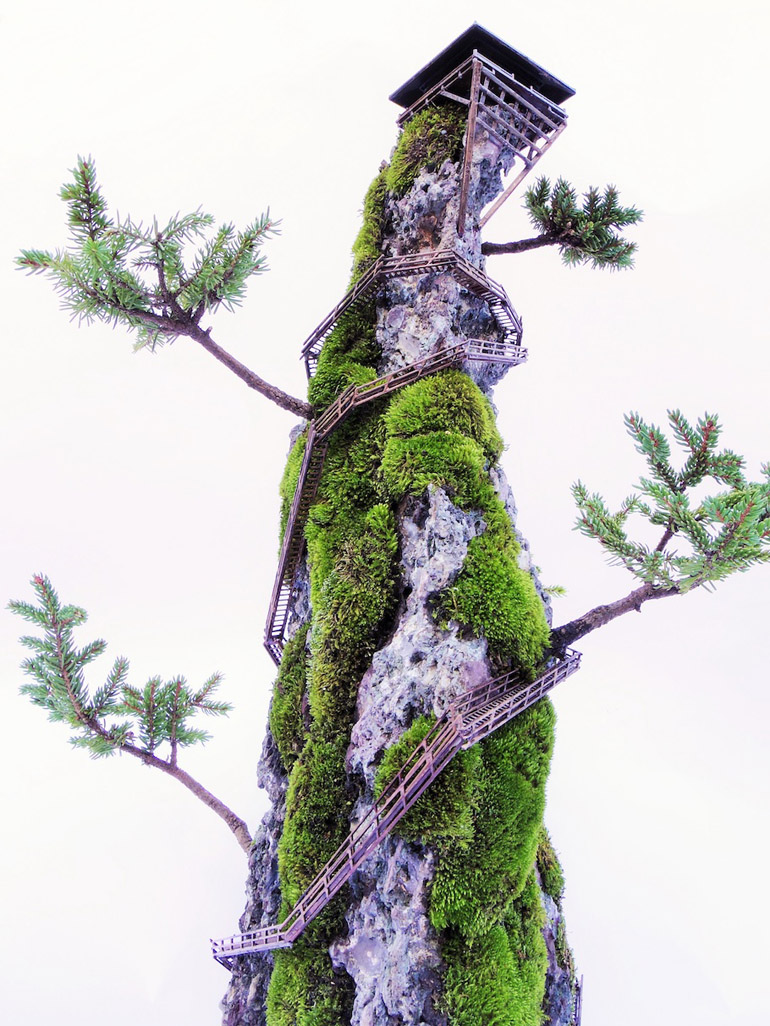
Another one

This one provides a little perspective. Smaller than you thought?
Here’s the course mentioned above…
Bjorn Bjorholm renowned American bonsai artist and teacher doing what he loves
Advanced Bonsai Course
Discounted pre-enrollment for the Advanced Bonsai Course has started! The online course offers unique access to the latest and most advanced Bonsai techniques. Instructor Bjorn Bjorholm guides you through the long-term impact of techniques on a wide variety of tree species.
Topics include heavy bending, various grafting techniques, creating deadwood and advanced design principles – for trees in different stages of development. But this course is not exclusively about advanced techniques. It also takes an unprecedented deep dive look into the philosophy and history of bonsai art, as well as aesthetic considerations that are crucial to improving your Bonsai skills.
The Best of DC – Our National Bonsai Treasure
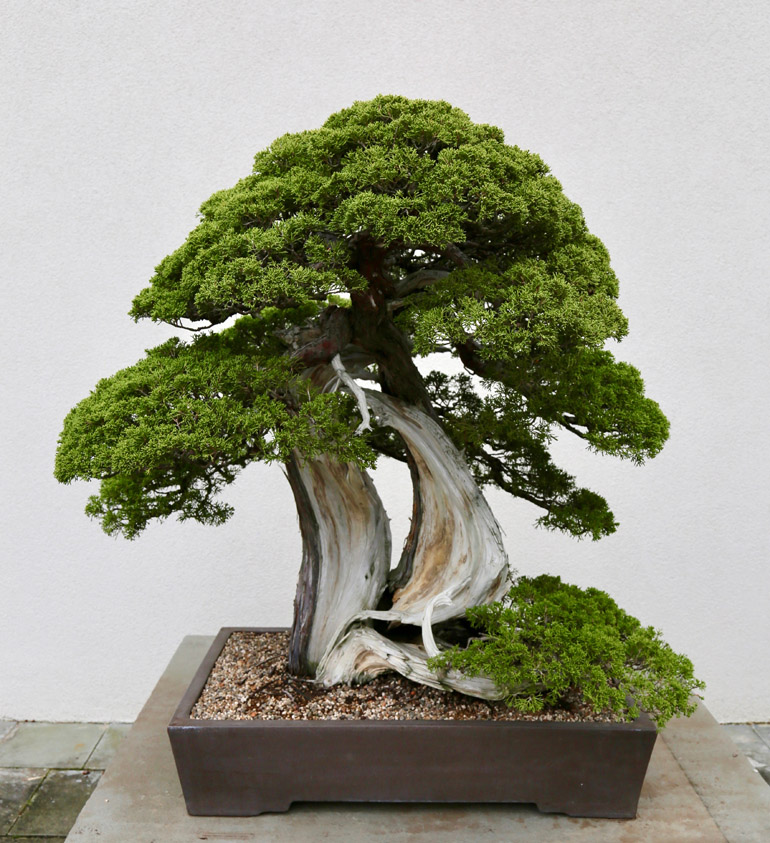
This Sargent juniper (Aka Shimpaku) resides at the U.S. National Bonsai and Penjing Museum. It was donated by Doug Paul, owner of the Kennett Collection. This photo and the others shown here, were taken and generously offered by Robert Vitale. The plant varieties and names of the donors are courtesy ofJanice Vitale and Michael James

The following is from our friend Felix Laughlin, President of the National Bonsai Foundation… “We are delighted to announce that the National Bonsai & Penjing Museum has been named the “Best Place to Take an Out-of-Towner” in Washington City Paper‘s Best of D.C. 2018 awards. Thanks to everyone who voted and helped spread the word about the national bonsai collection. We look forward to seeing you (and your out-of-town visitors) at the National Bonsai & Penjing Museum very soon.”
–

Closeup of Sedum in Rock Penjing “Li Jiang river in Spring.” Donated by the Shanghai Botanical Garden.

This iconic Japanese White Pine ‘Miyajima’ was donated by Daizo Iwasaki, one of the world's great bonsai benefactors. Iwasaki sama passed away in 2011.

Closeup of a Japanese White pine, that was gifted to Nancy Reagan by Hassan II King of Morocco. It has been in training since 1832
–
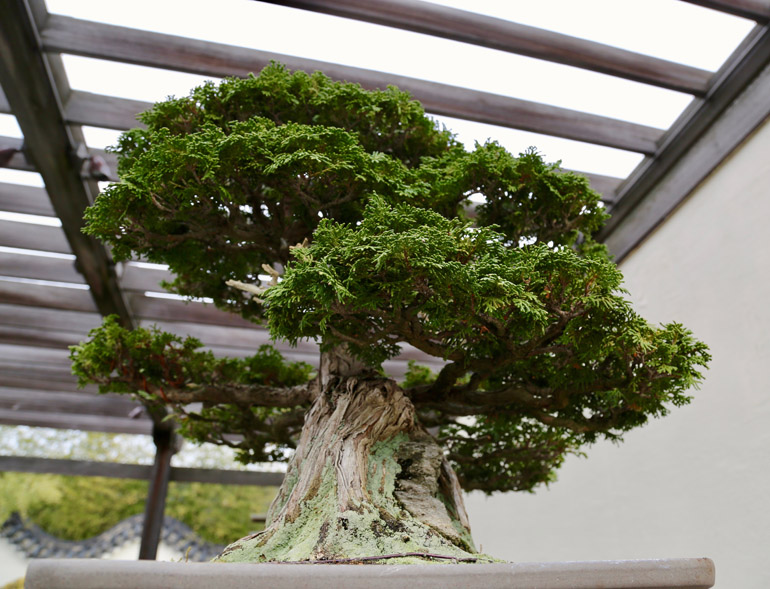
Hinoki Cypress donated by Muriel Leeds. In training since 1964

A piece of a Pitch pine that was also donated by Muriel Leeds. In training since 1967
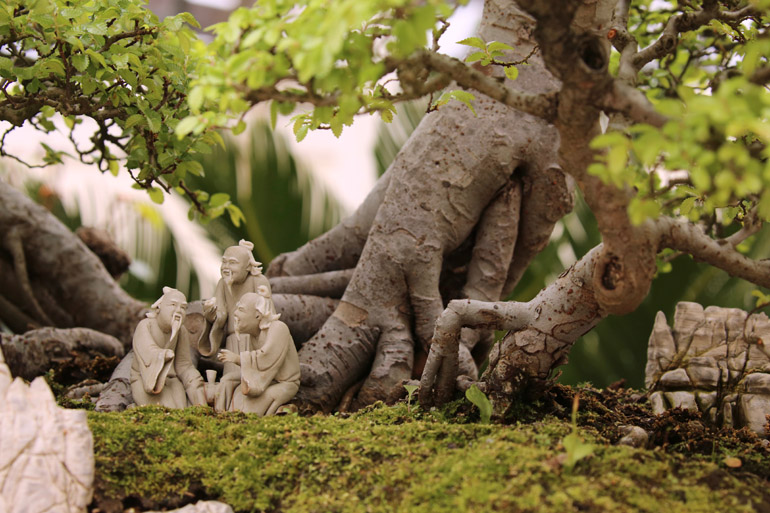
Close up of Chinese Elm penjing forest that was donated by Yunhua Hu. In training since 2004
Small Is Beautiful (& Practical Too)
This banyan style dwarf Snow rose serissa (Serissa foetida microphylla) was styled by David Fukumoto of Fuku Bonsai in Hawaii. The pot is a Tokoname from Japan. Living in the tropics is a big plus when it comes to growing aerial roots.
Monday morning, Stone Lantern’s peak season and the busiest time of year for bonsai growers, so it’s back to our archives. This one is from April, 2014
Based on thirty five years experience in bonsai business, I’d say that the majority of our readers and customers are into their middle years or beyond. I’m sure there are several good reasons for this, but I think it’s mostly because a slower more stable lifestyle allows the time and space to properly care for bonsai.
Continued below…
 Itoigawa juniper by Michael Hagedorn. Michael is one of our favorite American bonsai artists. If you haven't visited his site (Crataegus Bonsai) this is as good a time as any. BTW: Michael is the author of Post-Dated - The Schooling of an Irreverent Bonsai Monk a fascinating read, bonsai or otherwise.
Itoigawa juniper by Michael Hagedorn. Michael is one of our favorite American bonsai artists. If you haven't visited his site (Crataegus Bonsai) this is as good a time as any. BTW: Michael is the author of Post-Dated - The Schooling of an Irreverent Bonsai Monk a fascinating read, bonsai or otherwise.
Continued from above…
Which brings us to aging backs and smaller bonsai. On the back cover of Majesty in Miniature; Shohin Bonsai (out of print) it says “When compared to large bonsai, Shohin cost less, take less time to develop, take less space, are easier to move, and are less apt to be over-watered. Perhaps best of all, Shohin-bonsai are a delight to behold.” Easier to move and better suited to the small balcony on the retirement condo…
This brilliant Viginia creeper belongs to Harry Harrington, author of the Foundations of Bonsai and Bonsai Inspirations.
 This is sweet little Spiraea japonica also belongs to Harry Harrington.
This is sweet little Spiraea japonica also belongs to Harry Harrington.
Floating Mountains with Trees

Floating mountains with trees. I originally thought the trees with their tiny leaves might be boxwoods, but upon closer inspection, I think they are probably Serissas. This photo is a closeup from the photo just below.
This unusual and creative arrangement was posted by Aus Bonsai on facebook. It would be nice to know who the artist is, but Aus makes no mention of the artist or even provide a link to their source. If this were the first time, we wouldn’t mention it, but Aus Bonsai often fails in this regard (it’s one thing to not be able to hunt down the artist, but a whole other thing to not even provide a link to their source)*
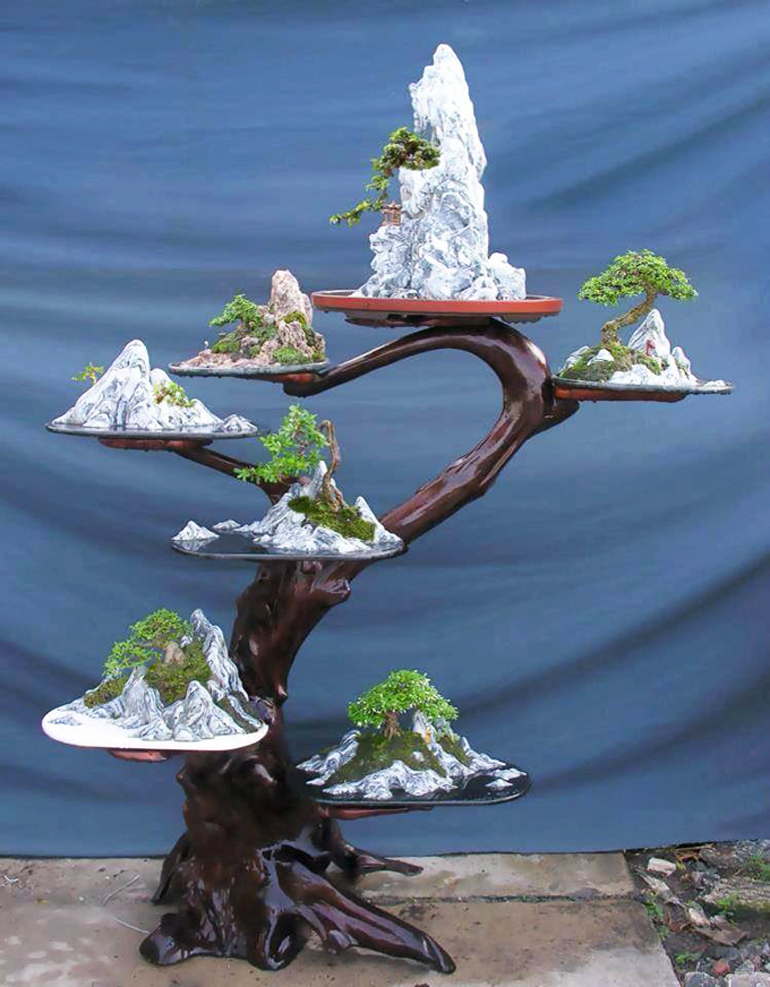
I like the way each planting looks like it could stand alone, and the way they all work together (even given the one with the mismatched rock).
A closer (fuzzier too) look to try to determine what the tree is. Is that a flower and some buds? Could it be a Serissa?
*This does beg the question of why we would bother to pass this along without attribution or even a link to original source. This is an ongoing issue when you try to post everyday and you find distinctive bonsai (like this one) worthy of sharing. Beyond that, I feel strongly about the importance of attribution, or at least links, and use Bark as an opportunity to bring the issue up from time to time.
By the way, I did a google image search, but came up with Aus Bonsai and Bonsai Bark. Not much help.
More Great Boxwood Bonsai

Aside from being a phenomenal tree and a great pot, there's a relaxed in-synch feeling, like the pot and tree are old friends. This might have something to do with the color, texture, soft lines and aged look of each. The color and feel of the stand fits right in too, while contrast is provided by its sharp rectangular lines. All together an excellent bonsai. The artist is François Gau (pot by Greg Ceramics). All three photos in this post are from Parlons Bonsai (I took the liberty to crop all three to bring the trees closer).
We featured Kingsville boxwoods a couple time this week, so continuing the theme (except for the Kingsville part). This post is from one we did on the 2013 European Bonsai San show. We’ve done some editing and have added a paragraph about wintering boxwoods.
Continued below…
This wild old tree is little more rough and rugged than the one above. That ruggedness and the long stretch of trunk without foliage, leans a little toward literati, though the lush foliage and deep pot betray that definition. If this were your tree, would you remove the strange branch on the left? Or maybe eliminate the inward growing foliage and create a jin? The artist is Raymond Claerr (pot by Isabelia).
The three trees shown here all have at least three things in common: They are all Boxwood bonsai (Buxus sempervirens). They all appeared in a 2013 bonsai show in Saulieu France (European Bonsai San Show). And, they all have powerful trunks.
Continued below…

When I first saw this tree, my eye went straight to the large hole at the base of the trunk and the jagged wood that frames it. It took a few moments and a more relaxed gaze to take in and appreciate the power of the whole tree. The artist is once again François Gau. The pot is Chinese and looks a lot like it might be Yixing.
I’ve had luck wintering boxwood indoors. I think it works best if you leave them out on a covered porch in the fall until night temperatures are well below freezing so they can experience at least a short period of dormancy (how cold depends on which type boxwood), and then bring them into a coolish place with plenty of light for the winter (old farmhouses often have rooms that aren’t heated and with adequate light… modern houses that are heated to 75F aren’t so good). If you live in a climate that has real winters but doesn’t get too cold, you can leave most boxwoods on a covered porch or in an out building all winter. If you live in a place with very mild winters, you can leave them out in the open.
Celebrating Bonsai & the Arrival of Our Bright Sun

This brilliant Deshojo Japanese maple (Acer palmatum var. Deshojo) and the equally brilliant rising sun scroll belong to Bill Valavanis.
All the photos shown here were borrowed from Bill Valavanis’ timeline. Here’s Bill’s caption… “Alcove display for tonight’s Introductory to Classical Bonsai Course. Deshojo Japanese maple displayed with a ripe strawberry accessory. Although the rising sun theme hanging scroll is generally only used once a year in Japan on New Year’s Day, it was used tonight to celebrate the bright sun and 85F weather we enjoyed during the day.”
By the way, Bill Valavanis is, in addition to being a highly respected bonsai artist and teacher, the founder and primary force behind the U.S. National Bonsai Exhibitions
Continued below…
–

Great close up
It’s time to remind you about the 6th U.S. National Bonsai Exhibition. It’s the premier North American celebration of bonsai. The one event you don’t want to miss and it’s only four months away (Sept 8th and 9th). We look forward to seeing you there!
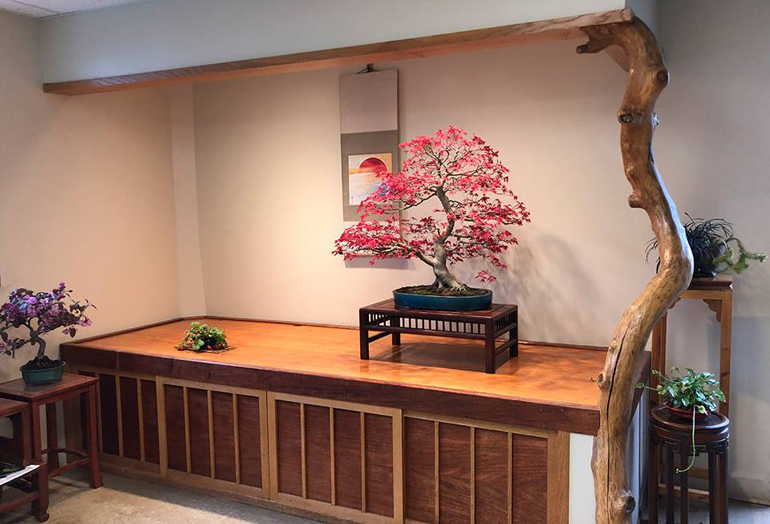
Bill's display alcove (Tokonama in Japanese)

Strawberries anyone? This sumptuous companion is a perfect fit with the rest of the display

The three main elements
Sweet Trees, but They Grow Microscopically…
You can tell this is a genuine Dwarf Kingsville boxwood by the tight tiny leaves. This planting by Boon Manakitivipart was the winner of the Certre Award at the 2010 U.S. National Bonsai Exhibition.
Continuing with Kingsville boxwoods and with Boon (see above), we’ve got three more Dwarf Kingsvilles today. Sweet trees, but they grow microscopically, so don’t expect fat trunks any time soon.
This has to one of the most perfectly conceived and executed Kingsville boxwoods you'll see anywhere. It belongs to Rodney Clemons, who wrote the following... “I am feeling honored I received word this week that two of my trees have been accepted for the 2018 US National Exhibition. I think they just really love to travel. Photo by Joe Noga, Container by an unknown Chinese artist, Stand by Charlie Clemons.”
A great pot and the finishing touches that the moss and soil present, don’t hurt this sweet little bonsai at all. This photo originally appeared on the cover of Bonsai Today issue 107. The tree belongs to Michael Persiano (co-editor of our Masters’ Series Pine book). You can see and read about its earlier stages of development in Bonsai Today issue 97.
Seven Pots for One Tree – What’s Your Choice?
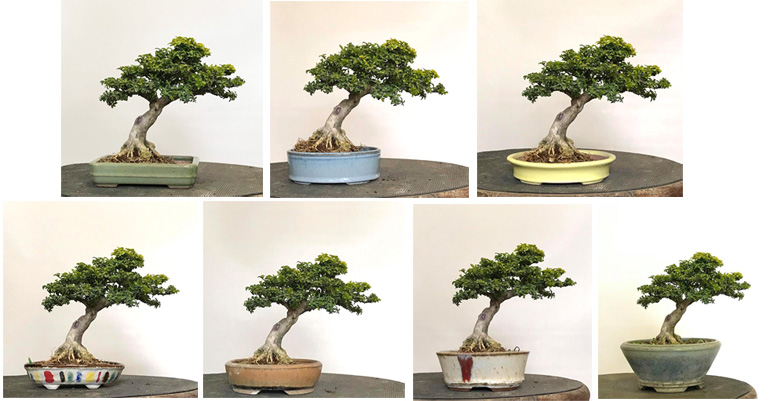
Seven choices for Boon's Kingsville boxwood. One stands out as by far the best choice for me, but I'm pretty sure we won't all agree. Which pot would you choose?
Boon Manakitivipart is at it again. Boon regularly posts his which pot? questions and we regularly borrow them. Judging by the response, it’s one of our most popular type posts, so as long as Boon is willing, we’ll keep putting them up. If you would like to share your choice, you can go to our facebook comments or you can go directly to the source (that would be Boon). Or you can do both.
–
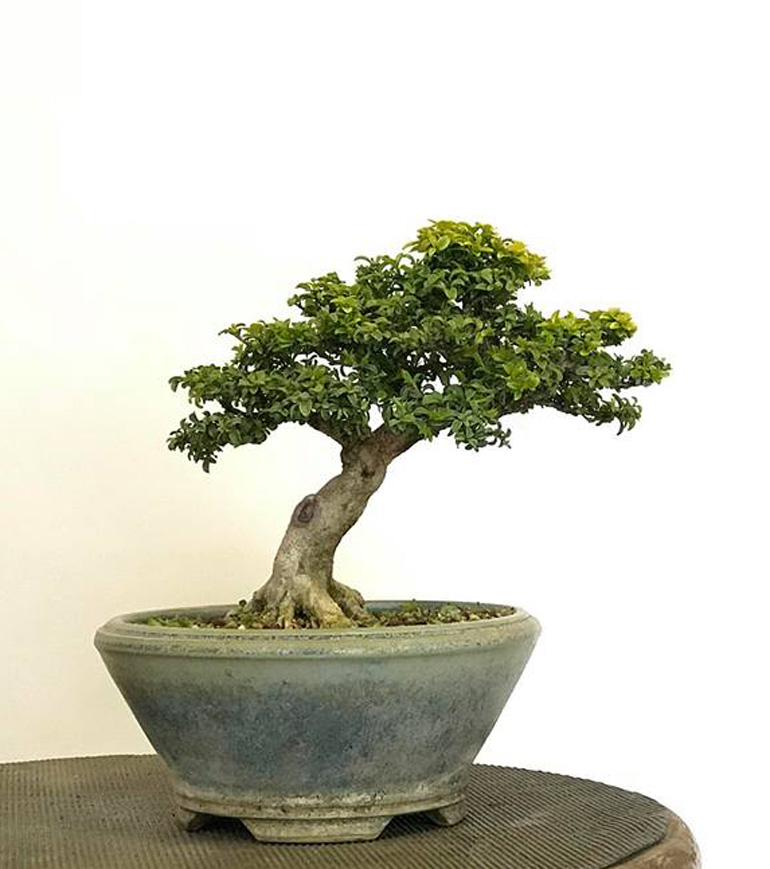
Pot #7

Pot #6

Pot #5
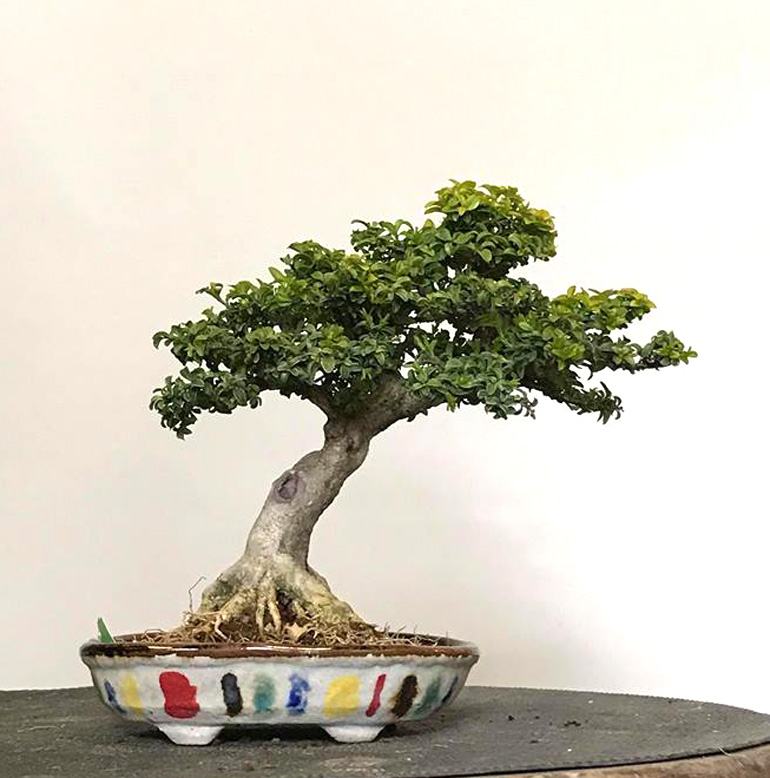
Pot #4

Pot #3

Pot #2

Pot #1


